Hardy Fortuna Fly Reels.
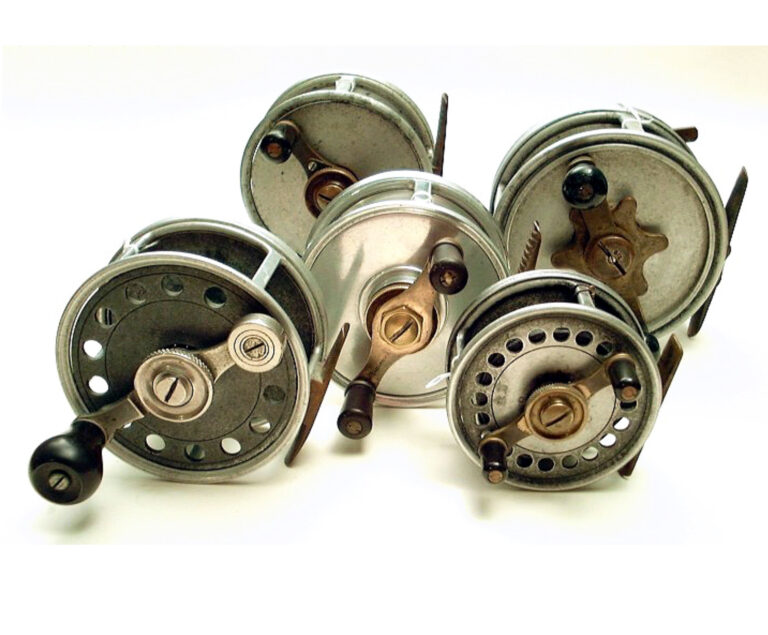
Hardy Fortuna Fly Reels.
Some time ago we wrote an article about the 4 1⁄4” size Fortuna fly reel which was published in another magazine. We have been requested to revise and re-issue that article for the readers of the ‘Antique Tackle Observer’.
Collecting Hardy’s fishing reels – and the company’s big game reels in particular was, and still is, a very effective method of consuming large numbers of banknotes. It is also still the case that we find it a constant source of interest and discovery. We continue to follow every new lead and pursue each and every avenue if we think it may expand our knowledge of this most elusive reel and its remarkable development.
Since writing the original article a fourth variant has joined our collection, and we hope the readers of the ‘Antique Tackle Observer’ will find the additional information together with this revision ensures those who may have read the other magazine do not simply turn the page.
Our research has primarily been conducted between the pages of Hardy’s Anglers Guides. In its heyday, this publication ran to more than 400 pages and contained a wealth of information for the angler at home and abroad, as well as offering a choice of the finest tackle for every class of fishing.
For this reason, the catalogues are now avidly sought worldwide by collectors of Hardy fishing tackle, and they are highly collectable in their own right. Though the bulk of information concerning fishing reels has been gleaned from these sources, the definitive dating of a certain modification or improvement has required many journeys to conduct research at the ‘Patent Office’ in London.
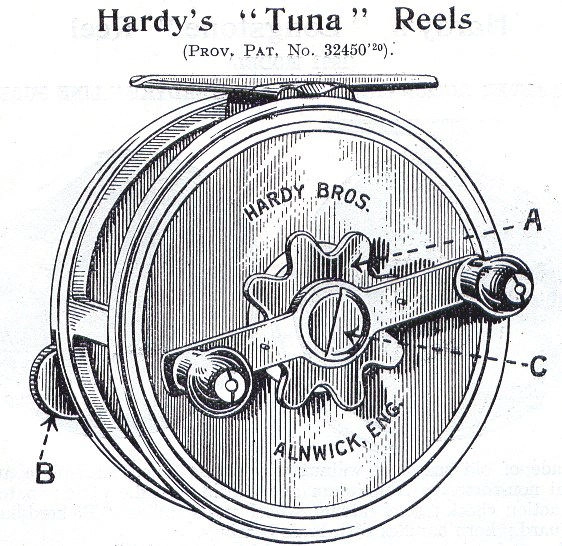
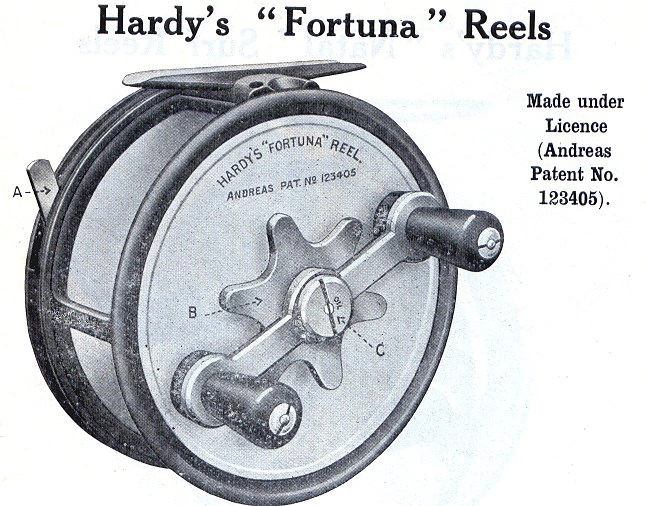
Left: Catalogue illustration from 1921 Right: Catalogue illustration from 1924
Though we endeavour to be clear and concise in our presentation, we recognise this is a difficult story to follow. We request the reader’s indulgence and hope we have been successful in our efforts to bring further understanding to this subject.
The period of this article begins in 1924 and ends when production of virtually all fishing tackle was halted immediately after the outbreak of War in 1939. Throughout this period there was variously a 4 1⁄4” Fortuna, a 4 1⁄4” Fortuna Fly, and a 4 1⁄4” Fortuna Junior.
The origin of the Fortuna can be traced back to the 1921 Tuna reel. The catalogue description – is fundamentally similar to the 1924 Fortuna both in appearance and the principles of design. This is confirmed by comparison of actual examples of ‘Tuna’ and’ Fortuna’ reels, to the catalogue illustrations. Indeed, these were so similar that Hardy’s simply re-named Tuna reels held in stock at the time of the name change by the attachment of a nameplate inscribed ‘Fortuna’ positioned over the ‘Tuna’ logo. This was discovered only after just such a crescent-shaped nameplate was removed to satisfy curiosity.
The range of sizes of the Fortuna included two sizes not offered in the Tuna range. A 31⁄2”, and the subject of this article – a 41⁄4 ”, both of which were identified from the outset as suitable for fly fishing.
The catalogue explains that the two smaller sizes differed from the 5”, 6”, and 7” models in one principle respect. The three larger sizes had a rim lever by which to select free spool.
The catalogue does not indicate how to make the spool run-free on the two smaller sizes. We would suggest that the first 41⁄4” Fortuna reel we have to show you provides the answer. Although it has a perforated drum similar to the reels pictured from 1925 onward (see below), it has a 4 bridge frame which is not shown in any catalogue illustration for any size of ‘Fortuna’.
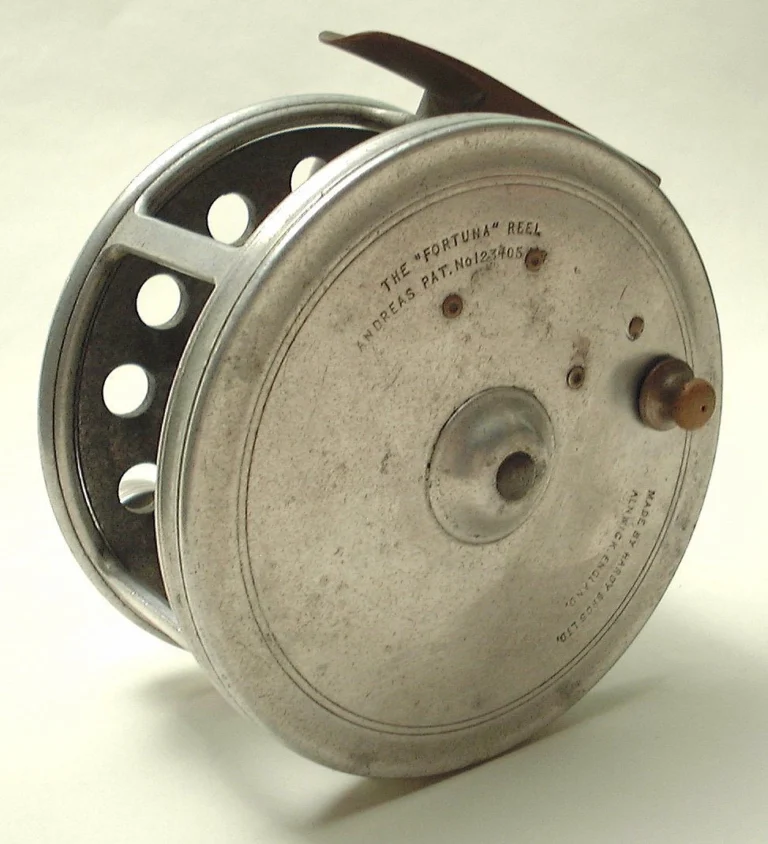

The 1924 model with the sliding anti-revers ratchet.
It also has a cranked bright nickel-plated counterbalanced handle bar which is an un-catalogued and uncharacteristic Hardy component. The backplate is marked with an acknowledgement of the ‘Andreas Patent’ 123405/18, and the name ‘Fortuna’, this determines the reel as a 1924 model. To disengage the anti-reverse ratchet on this reel there is a sliding knob on the backplate.
In the wider context, we can therefore say that the two smallest sizes of ‘Fortuna’ were, from their introduction, not simply small versions of the larger sizes but had several differences unique to their design.
In the 1925 Anglers Guide the 31⁄2”, 41⁄4”, and 5” sizes were transferred into the ‘Fresh Water Section’ and listed under the heading ‘Fortuna’. These three reels were stated to be ‘suitable for Fly-trolling’ and the 5”
size also suitable ‘for sea fishing’. As this was only the second season, it is all the more remarkable that the catalogue introduces several modifications to the design of these small ‘Fortunas. Quote ‘Turning the washer as far as possible to the left – the line drum is free running for paying out line’. In other words, the sliding knob on the backplate has been abandoned.
Furthermore, the accompanying illustration shows a reel still with a perforated line drum, but now with a three-bridge frame, a handlebar with twin handles, and a large knurled washer mounted over the handlebar.
To introduce a note of uncertainty here, it must be said that we are unaware of any 5” reel with a perforated line drum. However, since we have yet to see a 5” reel with the other features common to the 31⁄2”, and 41⁄4” reel during the 1925 – 30 period this matter is unresolved.


The 1928-1930 model front and back.
The following year the listing was headed ‘Fortuna Fly reels’ and all reference to the suitability for sea fishing had been deleted. The catalogue carried the same illustration, and largely similar text with only two amendments. First, the sentence concerning the free spool (quoted above) was deleted, and second, all mention of the suitability of the 5” reel for sea work was omitted.
The other point to note from the 1926 catalogue was a 25% price rise over the previous year. All the more remarkable because the price of Hardy’s other reels remained unchanged. The three sizes of ‘Fortuna Fly Reel’ continued to be listed in the catalogue without further advertised modification, until 1930.
This 41⁄4” reel has a solid drum but is in every other respect similar to the reels from the period 1925 – 1930. Furthermore, the ribbed foot dates the reel even more precisely to the period 1928 –1930.


Internal view of the 1931 Fortuna with close up detail of the handle right
For the 1931 catalogue, the Fortuna Fly reels were deleted, whilst the range of sizes of the Big Game Fortuna was increased to include a 41⁄4” and 5” size. It is likely that these two sizes from 1931 were henceforth fitted with Hardy’s 1930-patented improvements to the friction clutch.
The photographs clearly show the difference between the old friction clutch and the 1930 patent mechanism. This design introduced two interlocking cam plates sandwiched between the large knurled tension adjusting ring and the top face of the handle which is screwed into the second mating component.
The outer cam is a circular component keyed to the spindle shaft by a tongue on the inner diameter of the cam plate, the inner cam plate is screwed to the handlebar and is not keyed.

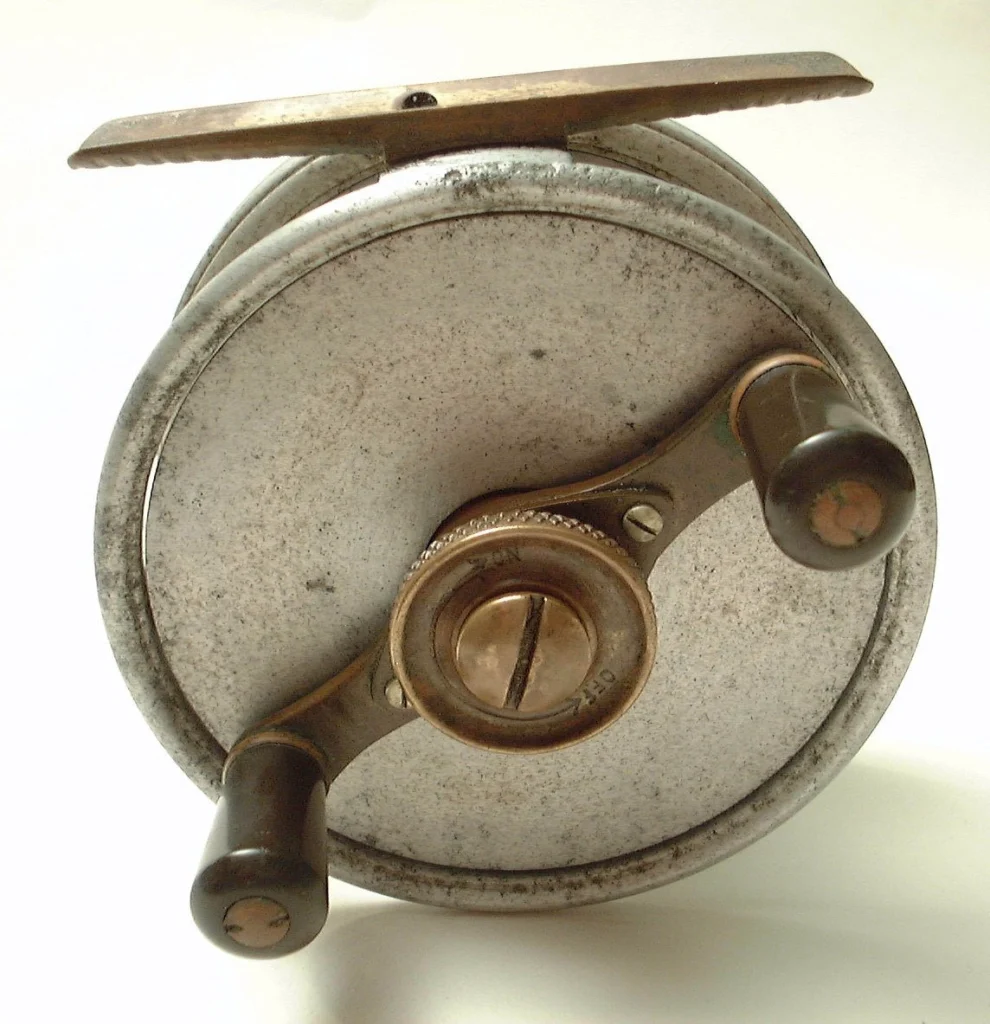
The 1931 model note the lever on the reverse view left.
The knurled tension adjuster when screwed down brings the cams into engagement and so provides the drive to the shaft. The lever on the backplate disengages the anti-reverse allowing the line to be paid out against the constant click check.
The backplate of this Fortuna also carries the ‘Andreas Patent’ number. The only indication made by the catalogues that this improvement had been introduced was in a brief comment first printed in the 1935 supplement alongside the ‘Fortuna Junior’.
Quote ‘The drive or wind-in is positive and of special design’, or in other words, the old design would allow the clutch to slip during wind-in if the load was too great or if it was incorrectly adjusted.
The other important point to note from the 1931 catalogue is that all sizes were fitted with a backplate lever which allowed the anti-reverse ratchet to be disengaged. This device can also be seen fitted to the reel pictured here. There was no full catalogue for the 1932 and 33 seasons, instead, Hardy’s published catalogue ‘supplements’ in which to introduce their new tackle.
The next full catalogue was published in 1934 and saw the 4 1⁄4” and 5” sizes still listed in the Big Game Fish section. In this catalogue, there are a couple of points to note.
First, the backplate lever has been discontinued, and secondly, there is no acknowledgement of the ’Andreas patent’ license arrangement. The reason for this is either the result of the company designing out the reliance on Andreas’s patented ideas, or the patent (and therefore, Hardy’s licence agreement) had been allowed to expire.
However, reels continued to be In 1935 Hardy’s published another marked with the Andreas patent catalogue supplement. This was also the number certainly up until after the year in which the company first of the 9” ‘Fortuna’s’ had been published their first dedicated Big made circa 1934. Game and Sea Fishing Catalogue. It seems more than coincidence that Hardy’s chose to separate the 4 1⁄4” and 5” sizes and list them separately as the Fortuna Junior.
The listing was brief, but as mentioned above, we get the first indication of the 1930 patent positive drive clutch. To illustrate the supplement Hardy resurrected the old picture of the ‘Fortuna Fly Reel’ with the perforated drum.
The Supplement to the 1936 catalogue does no more than announce a generous price reduction in the order of 20%.
The full catalogue for 1937 is illustrated by a reel with a solid line drum. In every other respect, there is no change to the 1936 Fortuna Junior.
The 1938 and 1939 seasons were covered by the publication of supplements, neither of which imparted any information about the Fortuna Junior. However, it is reasonable to assume that the Fortuna Junior would have continued to be available until the outbreak of War halted virtually all fishing tackle manufacture. Once existing stock was exhausted the future of the Fortuna Junior was held in limbo until the cessation of hostilities allowed normal production to resume. The first full catalogue was published in 1948 and, in common with the greater part of Britain’s manufactured output – the contents were for export only. In response to the exigencies of this country’s export drive, the company was ruthless in reducing the amount of tackle offered in this publication, with the Fortuna Junior sharing the same fate as many of the other specialised reels.
However, that is not quite the end of the story. In 1937 Hardy’s were successful with their patent application for further improvement to the clutch mechanism. Here we can see it first illustrated alongside the Zane Gray clutch in the 1948 export catalogue. The patent number for this improvement is 496163 and was published alongside the Zane Grey and the Fortuna. It is also impressed into the handlebar of this 4 1⁄4” reel disassembled component parts which has been disassembled to reveal the component parts.
The large circular knurled tension adjuster ring is now fitted beneath the handlebar and is different in design from the previous reels. It has a prominent spigot which bears down on the top plate of a new spring-loaded clutch arrangement located within the raised spigot housing in the centre of the drum face. The reel has the familiar fixed anti-reverse mechanism and constant click check. The ‘Andreas Patent’ number is not recorded on the reel.
This article has been concerned with just four versions of the 4 1⁄4” size Fortuna fly reel. Having visited and revisited the reels, catalogues and our own thoughts it is to be hoped that our understanding is now more nearly complete. At least we have again illustrated the diversity, effort, and commitment of resources Hardy put into the development of their reels. In the context of the total number produced in the 4 1⁄4” size of some eighty reels this is quite remarkable.
Our final comments may easily apply to the whole of Fishing tackle collecting. We have shown reels with solid line drums, a reel with a perforated drum, illustrations of reels with perforated drums, and of reels with solid drums. Where there is an apparent contradiction we have purposely not questioned whether the most appropriate illustration was published. Having learnt that rushing to judgment on these matters is to throw caution to the wind, we would rather say that we have yet to add a 4 1⁄4” Fortuna from the 1925 –1930 period with a perforated drum to our collection. After all, there are several well-publicised ‘catalogue errors’ which have subsequently been found to be correct and accurate.
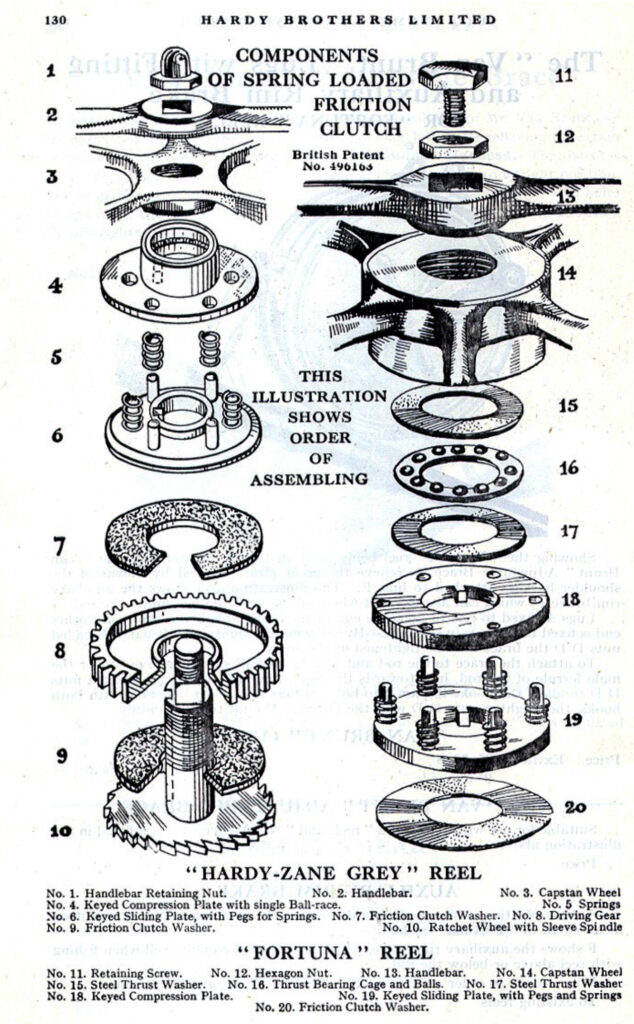
From the 1948 Export catalogue.